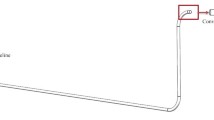Conclusions
-
1.
Analytical and graphical relationships between the number of pipes, their diameter, the flow of asphaltic material that can be passed through them and their depth of the immersion were derived on the basis of theoretical and experimental studies on the technology of the underwater placement of an asphalt lining in repairing hydraulic structures.
-
2.
The temperature-energy regime of the system encountered in placing an underwater asphaltic lining, which permits proper designation of pipe diameter as a function of the temperature of the asphaltic material and the water surrounding the delivery pipes, is studied.
-
3.
For lining under water, it is recommended that an asphalt mastic or solutions be employed as the most transportable materials, which make it possible to (fill all available recesses and which do not delaminate during transportation and lining.
Similar content being viewed by others
Literature cited
W. F. Asbeck, Bitumenin Wasserbau, Vol. 2 (1968), p. 416.
V. N. Yakovlev and M. G. Staritskii, Bituminous-Concrete Linings (A review of innovations in building designs, materials, and techniques) [in Russian], Énergiya, Moscow (1969).
N. F. Shchavelev, Sealing Deformation Joints in Massive Hydraulic Structures [in Russian], Énergiya, Moscow (1970).
V. M. Davidenko, Yu. N. Kasatkin, and N. A. Preobrazhenskaya, “Experimental-theoretical basis of the feasibility of repairing slope stabilization by the method of placing an underwater asphaltic lining,” News of the B. E. Vedeneev All-Union Scientific-Research Institute of Hydraulic Engineering [in Russian], Vol. 106, Énergiya, Leningrad (1974).
Instructions on the design and layout of monolithic bituminous-concrete linings for hydraulic structures. All-Union Construction Standard 17-68, Ministry of Power and Electrification of the USSR [in Russian], Vol. 103, Énergiya, Leningrad (1968).
M. A. Mikheev and N. M. Mikheeva, Short Course on Heat Transfer [in Russian], Gosénergoizdat, Moscow (1961).
N. F. Shchavelev, “Cooling of aspalt mastic in filling keyways,” in: Collection of Scientific Works of the Siberian Branch of the B. E. Vedneev All-Union Scientific-Research Institute of Hydraulics [in Russian], No. 3, Énergiya, Leningrad (1970).
Additional information
Translated from Gidrotekhnicheskoe Stroitel'stvo, No. 11, pp. 38–40, November, 1979.
Rights and permissions
About this article
Cite this article
Shchavelev, N.F., Davidenko, V.M. & Davidenko, G.A. Substantiating the method of underwater asphalt linings for the repair of hydraulic structures. Hydrotechnical Construction 13, 1114–1118 (1979). https://doi.org/10.1007/BF02307485
Issue Date:
DOI: https://doi.org/10.1007/BF02307485




